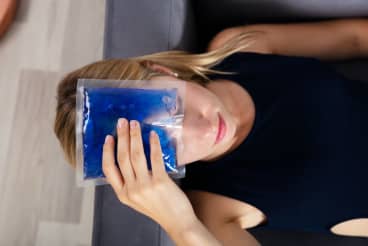 Arm Lift
Arm LiftA Guide To Using Compression Garments After Surgery
This post-procedure essential is a game changer for recovery.
While there are a lot of unknowns when it comes to healing from cosmetic surgery or an aesthetic procedure, there are plenty of products patients can pick up prior to surgery to help speed up the healing process and/or make themselves more comfortable — from scar-minimizing skincare to procedure-specific recovery pillows.
Another item that many surgeons recommend for post-op recovery? Compression garments. They’re helpful because they reduce the amount of swelling post-surgery and also provide support to core muscles during the healing process. While there are few downsides to using well-fitted compression garments post-op, there are some key details you’ll need to know before you shimmy into a set of your own.
To help you find out more about the ins and outs of compression garment usage, we’re breaking down all the things you need to know about this post-op essential.
Who Needs Compression Garments After Surgery?
Compression garments are most useful for patients who have undergone a body contouring procedure, including liposuction, abdominoplasty (a.k.a tummy tuck), brachioplasty (a.k.a. arm lift), and a Brazilian butt lift (BBL). The reason for this? In order to aid healing, your body will send fluid and white blood cells to the site of the surgery, which results in swelling. A compression garment will help reduce the amount of swelling that you experience, and it can also help to minimize bruising and scarring, as the tightness of the garment will hold your skin together and allow it to heal more optimally.
The type of garment required will depend on the procedure. Lipo and tummy tuck patients need a garment that will focus on the abdomen, while BBL patients should go for a longer garment that will support the buttocks without compressing the area. And while many think that compression garments are needed for a breast augmentation, it’s actually more important to wear a supportive (and wire-free) surgical bra after a breast implant procedure, rather than a compressive one.
How Tight Should Compression Garments Be?
Your surgeon should provide a list of post-op instructions that will lay out exactly what you need post-op, but, as a general rule of thumb, you’ll want it to be snug without feeling overly squished or restricted. An ill-fitting garment can actually do more harm than good. If it’s too small, it can impact blood flow and cause irregularities in your healing. Signs of impacted blood flow include numbness, tingling, and paleness of the extremities. A garment that is too big, meanwhile, simply won’t be effective.
The best way to make sure you order properly sized compression-wear is to measure yourself and compare it to the guide on the website of the manufacturer — but don’t be afraid to go up or down a size if the one you order doesn’t fit at first. Your doctor may recommend that you pick up two garments, one for the first few weeks after surgery and a slightly smaller one for when your swelling goes down.
How Long Do Compression Garments Need to Be Worn?
The specifics of how long you’ll have to wear the garment is determined by your provider, but there are some general milestones you can keep in mind as you plan your recovery journey:
- First Month: You’ll likely wear the compression garment full-time for three to four weeks, taking it off only to bathe.
- Second & Third Month: After the first month, you can probably cut wear time to 12 hours for the next six to eight weeks.
- Ongoing Care: Post-op swelling can last three to six months, so it may be necessary to wear compression garments for a longer period of time, albeit in shorter stints.
Ensuring the skin underneath the garment is clean and dry is essential to avoid chafing, irritation, and bacterial or fungal infections that can impair wound healing. Allow the area to dry completely after bathing or sweating and be sure to launder the garment as needed.
Top-Rated Compression Garments
Your doctor will likely give you recommendations for the best compression garments to purchase based on your procedure, but these five are top-rated by patients:
- Tummy Tuck: The Macom Abdominal Compression Garment comes with handy side hooks that can be adjusted once your initial swelling subsides.
- Brazilian Butt Lift: The lightweight Marena Recovery Compression Bodysuit has an infinity-edge opening for the buttocks, providing both compression and gentle support.
- Liposuction: These High-Waisted Compression Shorts are great for a number of procedures, including liposuction of the flanks and inner or outer thigh.
- Arm Lift: Give your arms the support they need with this ¾-Length Arm Sleeve.
- Foam Insert Vest: While a good-quality compression garment won’t rub or cause irritation, this foam insert can be placed in between your skin and the garment for greater comfort. It’ll provide additional compression, while keeping the area flat.
The Takeaway
Compression garments help promote healing after body procedures by minimizing swelling, decreasing bruising, supporting the underlying musculature, and holding skin together. The fit and sizing of your garment are important, and you should consult your doctor to find out how long you should wear it after surgery.
All products featured are independently selected by our editors, however, AEDIT may receive a commission on items purchased through our links.
More Related Articles
Related Procedures

AI Plastic Surgeon™
powered by'Try on' aesthetic procedures and instantly visualize possible results with The AI Plastic Surgeon, our patented 3D aesthetic simulator.


